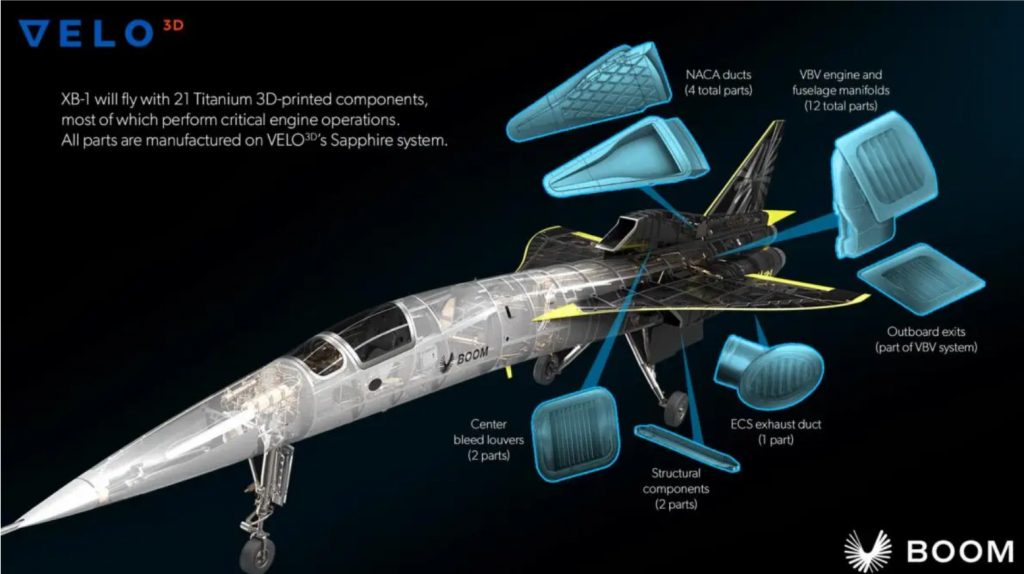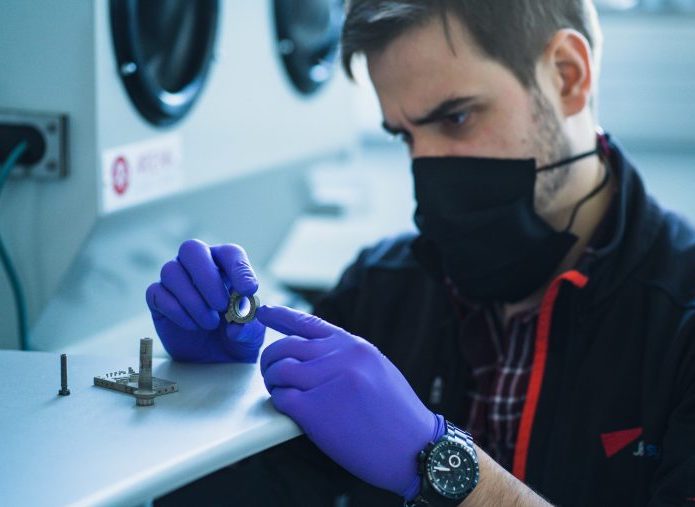Aerospace firm Boom Supersonic has gained a contract worth up to $60 million from the US Air Force (USAF) to accelerate the R&D of its upcoming ‘Overture’ supersonic flight-capable aircraft.
Awarded via the USAF’s AFWERX innovation arm, the ‘STRATFI’ funding is designed to help ramp up the aero and engine-testing programs of the Overture, whose initial XB-1 demonstrator is being partially-built using 3D printing. Set to be capable of carrying up to 88 passengers at twice the speed of today’s airliners, while also running on 100% sustainable fuels, the Overture is slated to enter service by 2030.
“With STRATFI, we’re able to collaborate with the Air Force on the unique requirements and needs for global military missions, ultimately allowing Boom to better satisfy the needs of the Air Force,” said Boom Supersonic CEO Blake Scholl. “As a potential future platform for the Air Force, Overture would offer the valuable advantage of time, an unmatched option domestically and internationally.”
“We are proud of the Air Force’s continued support and recognition of Boom’s leadership in supersonic flight—and we see our partnership as mutually beneficial.”

Boom’s supersonic flight ambition
Founded in 2014, with the aim of bringing back commercial supersonic air travel for the first time since the Concorde made its final flight in 2003, Boom Supersonic unveiled its inaugural aircraft demonstrator in October 2020. Known as the ‘XB-1,’ this proof-of-concept airliner is being built to prove the viability of the firm’s Mach 2.2-capable Overture design.
Even though this prototype will only be a third of the Overture’s size, its custom composite structure still comprises over 3,700 parts including landing gear, flight control actuators and cooling systems. To take on the mammoth task of building this demonstrator, Boom Supersonic has often turned to 3D printing, first using Stratasys’ F370 and Fortus 3D printers to develop XB-1 tooling and prototypes.
Two years later, the company agreed a longer-term partnership with Stratasys, which has seen the firms move beyond rapid prototyping, and into the production of end-use parts for both the XB-1 and potentially the Overture. This deal was followed by a similar agreement with VELO3D, which has since seen Boom Supersonic 3D print another 21 XB-1 parts, including vanes, ducts and louvres.
Despite the fact the XB-1 hasn’t flown since it was rolled-out in late 2020, Boom Supersonic has so far managed to secure $270 million to fund its development, as well as an order for 15 Overtures from United Airlines. While the firm initially announced the prototype would be flight tested in 2021, this now appears to have been delayed, although it hasn’t shifted the Overture’s slated launch date as of yet.

The Overture gets Air Force backing
Boom Supersonic’s latest backing comes from both the USAF’s AFWERX and AFVentures divisions. Set up to foster a culture of innovation across the service, AFWERX encompasses a number of investment programs such as AFVentures, which are designed to fund the R&D of commercial technologies that could help solve USAF problems.
The capital itself has been awarded as a Strategic Funding Increase or ‘STRATFI’ contract, the likes of which are typically dished out to help the recipients of SBIR/STTR funding scale their efforts in a way that advances the USAF’s strategic capabilities, with prior awardees including operational AI developer Falkonry and space sensor producer Orbital Sidekick.
In Boom Supersonic’s case, its newly-raised funding supplements that it was awarded as part of an initial SBIR Phase 2 contract in September 2020. Leveraging this additional backing, the firm now intends to accelerate some of the critical steps in the Overture’s R&D, such as its wind tunnel testing and propulsion system definition programs.
Framed as a three-year ‘strategic partnership,’ the award also represents a substantial increase in the USAF’s investment in Boom Supersonic, and it’s thought that a successor to the Overture could go on to enhance the service’s rapid global transport and logistical capabilities, particularly within its executive transport, intelligence, surveillance, recon, Special Ops or Pacific Air Force operations.
In terms of its commercial launch, Boom Supersonic says that the Overture is expected to enter production next year, before being rolled out in 2025 and beginning to fly passengers “by the end of the decade.”

Advances in flight-ready 3D printing
During the last year alone, a rising number of aviation firms have begun to adopt 3D printing as a means of optimizing the weight, lead times and costs associated with the creation of flight-ready aircraft components. In recent binder jet 3D printing trials, JPB Système found that it was able to make some of its aerospace parts 30% lighter and up to 80% faster than before.
Airbus has also used Materialise 3D printing for some time, having first deployed FDM technology to produce elements of its A350 aircraft several years ago, but in June 2021, the firm took this a step further by making the firm the first qualified to SLS 3D print parts for its craft, under its Process Specification AIPS 03-07-022.
Elsewhere, on a national-level, the state-owned conglomerate Rostec gained a license from the Russian Ministry of Industry and Trade to serially 3D print aerospace parts earlier this month. As the first Russian firm to publicly confirm its intention to deploy industrial 3D printing in aviation, the business is now reportedly allowed to produce and test airline, helicopter and engine components.
To stay up to date with the latest 3D printing news, don’t forget to subscribe to the 3D Printing Industry newsletter or follow us on Twitter or liking our page on Facebook.
For a deeper dive into additive manufacturing, you can now subscribe to our Youtube channel, featuring discussion, debriefs, and shots of 3D printing in-action.
Are you looking for a job in the additive manufacturing industry? Visit 3D Printing Jobs for a selection of roles in the industry.
Featured image shows Boom Supersonic’s XB-1 demonstrator aircraft. Photo via Boom Supersonic.



